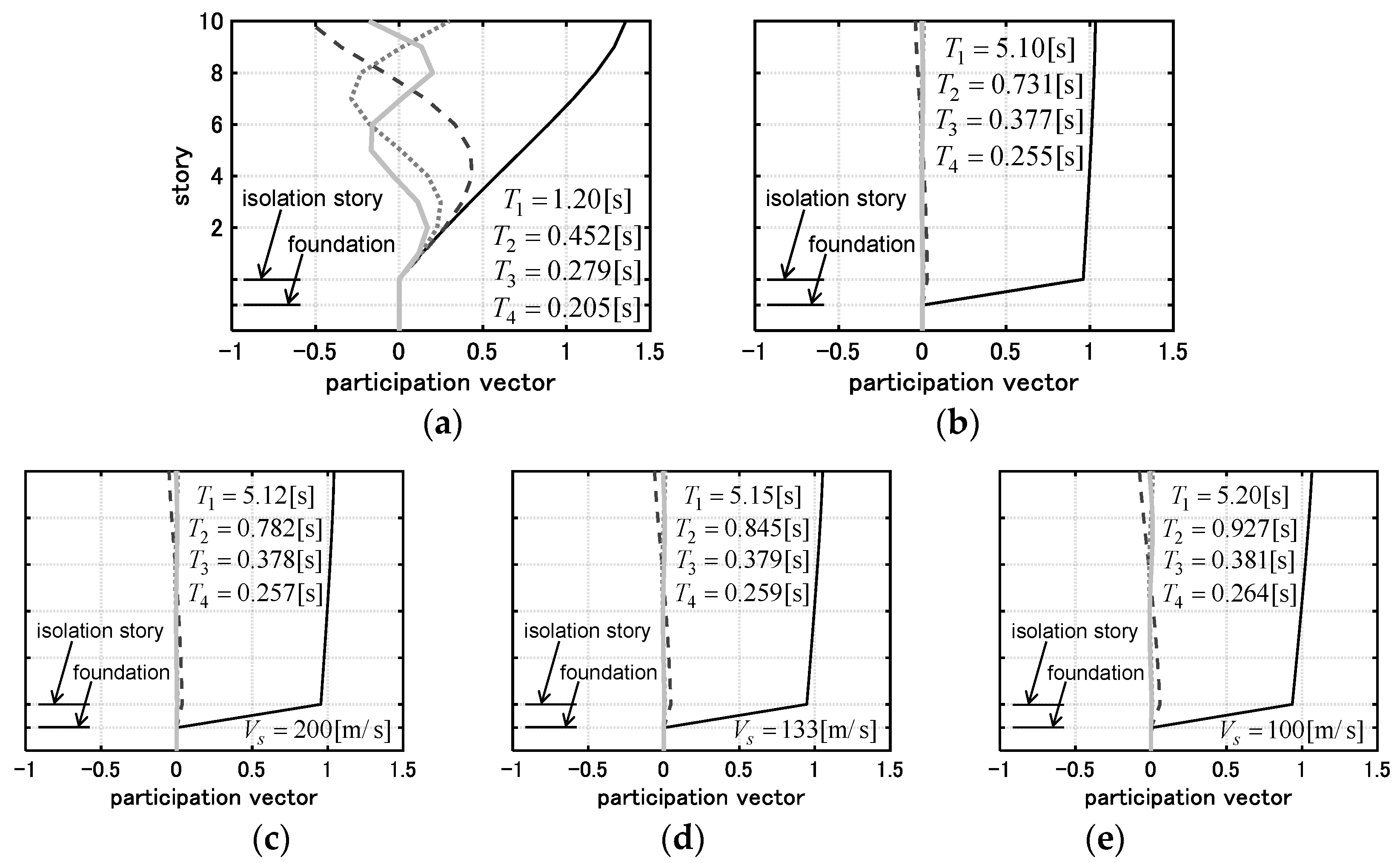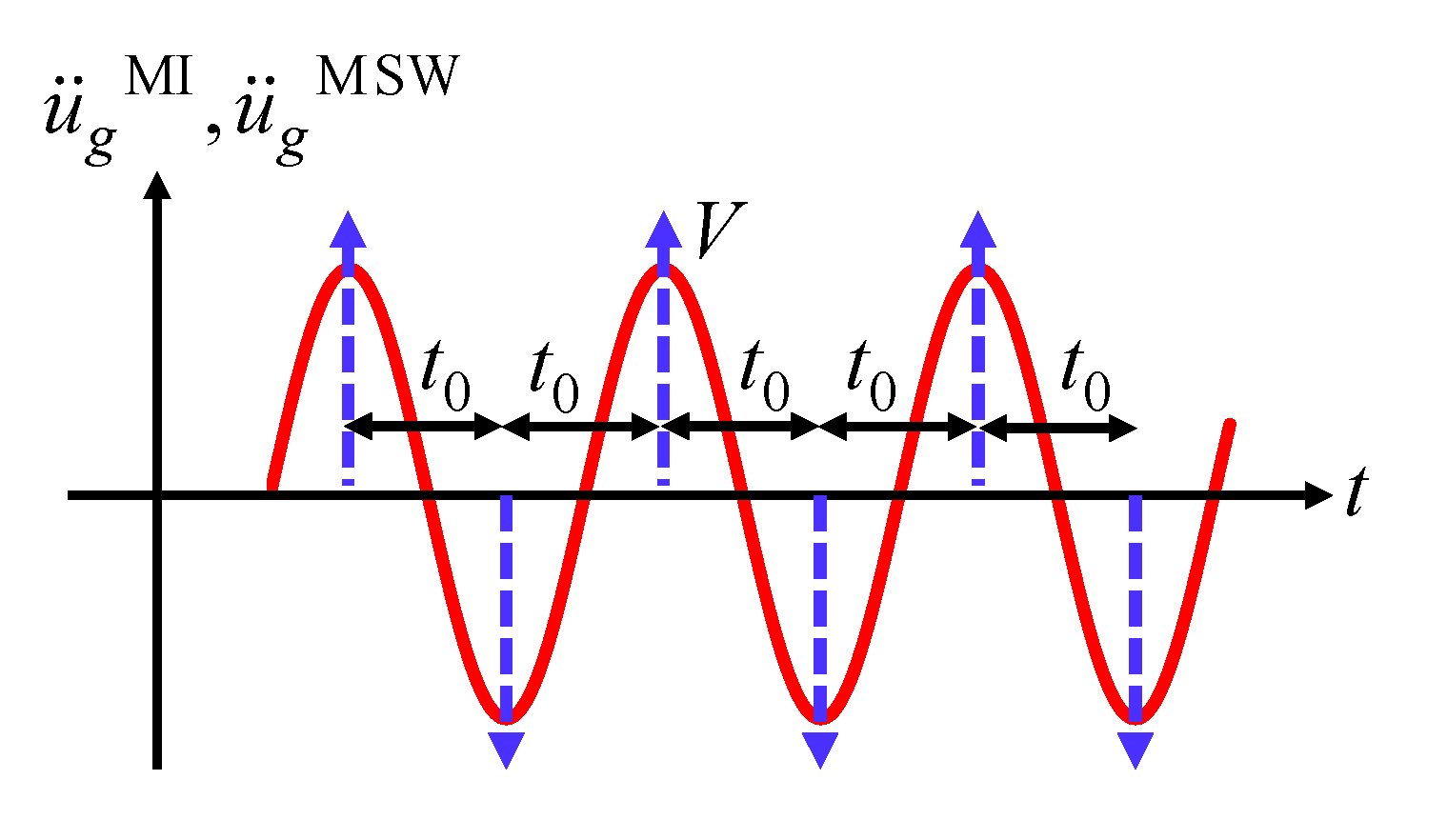Critical Analysis of Nonlinear Base-Isolated Building Considering Soil–Structure Interaction under Impulsive and Long-Duration Ground Motions
Abstract
:1. Introduction
2. Double Impulse as Substitute of Fling-Step Ground Motion
3. Base-Isolated Building Considering Soil–Structure Interaction
4. Critical Impulse Timing
4.1. Critical Impulse Timing That Maximizes Total Input Energy to Whole System
4.2. Critical Impulse Timing That Maximizes Instantaneous Input Energy to Base-Isolated Building Excluding Swaying-Rocking Spring-Dashpot System
5. Numerical Examples
5.1. Building Model
5.2. Double Impulse
5.3. One-Cycle Sine Wave
6. Soil–Structure Interaction under Long-Duration Ground Motions
7. Discussion
8. Conclusions
- A one-cycle sine wave and a double impulse effectively express a main characteristic of a fling-step motion. The use of the double impulse enables the capturing of the critical input period for elastic-plastic MDOF models without repetition. On the other hand, in the case of the one-cycle sine wave, an iterative procedure with much computational effort is required to obtain the critical responses of the elastic-plastic MDOF models by parametrically changing the input period.
- The critical impulse timing was derived that maximizes the total input energy to the whole system for MDOF building models supported by a swaying-rocking spring-dashpot system. The maximization of the total input energy is equal to the maximization of the input energy by the second impulse. The critical condition is that the sum of the forces by the swaying spring-dashpot of the ground after the first impulse is equal to zero.
- Another type of the critical impulse timing was derived that maximizes the instantaneous input energy to a base-isolated building excluding the swaying-rocking system. The critical condition is that the sum of the forces by the restoring force and the damping force of the base-isolation story after the first impulse is equal to zero. The two types of critical timings were shown to be almost equal. This means that the total input energy to the whole system and the instantaneous input energy to the base-isolated building excluding the swaying-rocking spring-dashpot system are maximized at almost the same time.
- The maximum responses under the critical double impulse are about 1.1 times larger than those under the corresponding one-cycle sine wave. Moreover, the time-history of the deformation and the restoring force of the base-isolation story under the critical double impulse and the corresponding one-cycle sine wave correspond well. Therefore, the critical double impulse works well to simulate the critical responses under the one-cycle sine wave.
- The multi impulse was employed to simulate the critical response of a base-isolated buildings supported by a swaying-rocking spring-dashpot system under long-duration ground motions.
- The duration of ground motion plays a key role in the critical responses of base-isolated buildings on flexible ground. The soil–structure interaction has negative effects on the maximum responses of base-isolated buildings under long-duration ground motions, although it has slightly negative effects under short-duration motions.
Author Contributions
Funding
Conflicts of Interest
References
- Kelly, J.M.; Konstantinidis, D. Mechanics of Rubber Bearings for Seismic and Vibration Isolation; Wiley: Chichester, UK, 2011; Volume 222. [Google Scholar]
- Lagaros, N.D. (Ed.) Design Optimization of Active and Passive Structural Control Systems; IGI Global: Hershey, PA, USA, 2012. [Google Scholar]
- Takewaki, I.; Akehashi, H. Comprehensive review of optimal and smart design of nonlinear building structures with and without passive dampers subjected to earthquake loading. Front. Built Environ. 2021, 7, 211. [Google Scholar] [CrossRef]
- Matsagar, V.A.; Jangid, R.S. Base isolation for seismic retrofitting of structures. Pract. Period. Struct. Des. Constr. 2008, 13, 175–185. [Google Scholar] [CrossRef]
- Jangid, R.S.; Kelly, J.M. Base isolation for near-fault motions. Earthq. Eng. Struct. Dyn. 2001, 30, 691–707. [Google Scholar] [CrossRef]
- Tsai, H.C.; Kelly, J.M. Seismic response of heavily damped base isolation systems. Earthq. Eng. Struct. Dyn. 1993, 22, 633–645. [Google Scholar] [CrossRef]
- Hall, J.F.; Heaton, T.H.; Halling, M.W.; Wald, D.J. Near-source ground motion and its effects on flexible buildings. Earthq. Spectra 1995, 11, 569–605. [Google Scholar] [CrossRef]
- Lou, M.; Wang, H.; Chen, X.; Zhai, Y. Structure-soil-structure interaction: Literature review. Soil Dyn. Earthq. Eng. 2011, 31, 1724–1731. [Google Scholar] [CrossRef]
- Wolf, J.P. Soil-structure-interaction analysis in time domain. In Structural Mechanics in Reactor Technology; Electrowatt Engineering Services Ltd.: Zurich, Switzerland, 1987. [Google Scholar]
- Gazetas, G.; Mylonakis, G. Soil-structure interaction effects on elastic and inelastic structures. In Proceedings of the International Conferences on Recent Advances in Geotechnical Earthquake Engineering and Soil Dynamics, San Diego, CA, USA, 26–31 March 2001; Volume 3. [Google Scholar]
- Mylonakis, G.; Gazetas, G. Seismic soil-structure interaction: Beneficial or detrimental? J. Earthq. Eng. 2000, 4, 277–301. [Google Scholar] [CrossRef]
- Takewaki, I. Equivalent linear ductility design of soil-structure interaction systems. Eng. Struct. 1998, 20, 655–662. [Google Scholar] [CrossRef]
- Takewaki, I. Probabilistic critical excitation for MDOF elastic-plastic structures on compliant ground. Earthq. Eng. Struct. Dyn. 2001, 30, 1345–1360. [Google Scholar] [CrossRef]
- Takewaki, I.; Murakami, S.; Fujita, K.; Yoshitomi, S.; Tsuji, M. The 2011 off the Pacific coast of Tohoku earthquake and response of high-rise buildings under long-period ground motions. Soil Dyn. Earthq. Eng. 2011, 31, 1511–1528. [Google Scholar] [CrossRef] [Green Version]
- Garevski, M.; Gjorgiev, I.; Edip, K.; Sesov, V.; Cvetanovska, J. Effects of soil medium on response of base isolated multistory frame structures. In Proceedings of the 15th World Conference on. Earthquake Engineering 2012, (15WCEE), Lisbon, Portugal, 24–28 September 2012. [Google Scholar]
- Haiyang, Z.; Xu, Y.; Chao, Z.; Dandan, J. Shaking table tests for the seismic response of a base-isolated structure with the SSI effect. Soil Dyn. Earthq. Eng. 2014, 67, 208–218. [Google Scholar] [CrossRef]
- Novak, M.; Henderson, P. Base-isolated buildings with soil-structure interaction. Earthq. Eng. Struct. Dyn. 1989, 18, 751–765. [Google Scholar] [CrossRef]
- Spyrakos, C.C.; Maniatakis, C.A.; Koutromanos, I.A. Soil-structure interaction effects on base-isolated buildings founded on soil stratum. Eng. Struct. 2009, 31, 729–737. [Google Scholar] [CrossRef]
- Tongaonkar, N.; Jandid, R. Seismic response of isolated bridges with soil-structure interaction. Soil Dyn. Earthq. Eng. 2003, 23, 287–302. [Google Scholar] [CrossRef]
- Forcellini, D. Cost assessment of isolation technique applied to a benchmark bridge with soil structure interaction. Bull. Earthq. Eng. 2016, 15, 51–69. [Google Scholar] [CrossRef]
- Forcellini, D. Seismic assessment of a benchmark based isolated ordinary building with soil structure interaction. Bull. Earthq. Eng. 2017, 16, 2021–2042. [Google Scholar] [CrossRef]
- Luco, J.E. Effects of soil-structure interaction on seismic base isolation. Soil Dyn. Earthq. Eng. 2014, 66, 167–177. [Google Scholar] [CrossRef]
- Akehashi, H.; Kojima, K.; Fujita, K.; Takewaki, I. Critical response of nonlinear base-isolated building considering soil-structure interaction under double impulse as substitute for near-fault ground motion. Front. Built Environ. 2018, 4, 34. [Google Scholar] [CrossRef]
- Akehashi, H.; Takewaki, I. Critical response of nonlinear base-isolated building considering soil-structure interaction. In Proceedings of the 17th World Conference on Earthquake Engineering 2020, 17WCEE, Sendai, Japan, 13–18 September 2020. [Google Scholar]
- Skinner, R.I.; Robinson, W.H.; McVerry, G.H. An Introduction to Seismic Isolation; Wiley: Hoboken, NJ, USA, 1993. [Google Scholar]
- Hayden, C.P.; Bray, J.D.; Abrahamson, N.A. Selection of near-fault pulse motions. J. Geotech. Geoenviron. Eng. 2014, 140, 04014030. [Google Scholar] [CrossRef]
- Kalkan, E.; Kunnath, S.K. Effects of fling step and forward directivity on seismic response of buildings. Earthq. Spectra 2006, 22, 367–390. [Google Scholar] [CrossRef]
- Kojima, K.; Takewaki, I. Critical earthquake response of elastic-plastic structures under near-fault ground motions (Part 1: Fling-step input). Front. Built Environ. 2015, 1, 12. [Google Scholar] [CrossRef] [Green Version]
- Makris, N.; Black, C.J. Dimensional analysis of rigid-plastic and elastoplastic structures under pulse-type excitations. J. Eng. Mech. 2004, 130, 1006–1018. [Google Scholar] [CrossRef]
- Sasani, M.; Bertero, V.V. Importance of severe pulse-type ground motions in performance-based engineering: Historical and critical. In Proceedings of the 12th World Conference on Earthquake Engineering, New Zealand Society for Earthquake Engineering, Upper Hutt, New Zealand, 30 January–4 February 2020. [Google Scholar]
- Akehashi, H.; Takewaki, I. Optimal viscous damper placement for elastic-plastic MDOF structures under critical double impulse. Front. Built Environ. 2019, 5, 20. [Google Scholar] [CrossRef] [Green Version]
- Parmelee, R.A. The influence of foundation parameters on the seismic response of interaction systems. In Proceedings of the Third Japan Earthquake Engineering Symposium, Tokyo, Japan, 17–20 November 1970; Volume 3, pp. 49–56. [Google Scholar]
- Akehashi, H.; Kojima, K.; Farsangi, E.N.; Takewaki, I. Critical response evaluation of damped bilinear hysteretic SDOF model under long duration ground motion simulated by multi impulse motion. Int. J. Earthq. Impact Eng. 2018, 2, 298–321. [Google Scholar] [CrossRef] [Green Version]






















Publisher’s Note: MDPI stays neutral with regard to jurisdictional claims in published maps and institutional affiliations. |
© 2021 by the authors. Licensee MDPI, Basel, Switzerland. This article is an open access article distributed under the terms and conditions of the Creative Commons Attribution (CC BY) license (https://creativecommons.org/licenses/by/4.0/).
Share and Cite
Akehashi, H.; Takewaki, I. Critical Analysis of Nonlinear Base-Isolated Building Considering Soil–Structure Interaction under Impulsive and Long-Duration Ground Motions. Geotechnics 2021, 1, 76-94. https://doi.org/10.3390/geotechnics1010005
Akehashi H, Takewaki I. Critical Analysis of Nonlinear Base-Isolated Building Considering Soil–Structure Interaction under Impulsive and Long-Duration Ground Motions. Geotechnics. 2021; 1(1):76-94. https://doi.org/10.3390/geotechnics1010005
Chicago/Turabian StyleAkehashi, Hiroki, and Izuru Takewaki. 2021. "Critical Analysis of Nonlinear Base-Isolated Building Considering Soil–Structure Interaction under Impulsive and Long-Duration Ground Motions" Geotechnics 1, no. 1: 76-94. https://doi.org/10.3390/geotechnics1010005
APA StyleAkehashi, H., & Takewaki, I. (2021). Critical Analysis of Nonlinear Base-Isolated Building Considering Soil–Structure Interaction under Impulsive and Long-Duration Ground Motions. Geotechnics, 1(1), 76-94. https://doi.org/10.3390/geotechnics1010005




